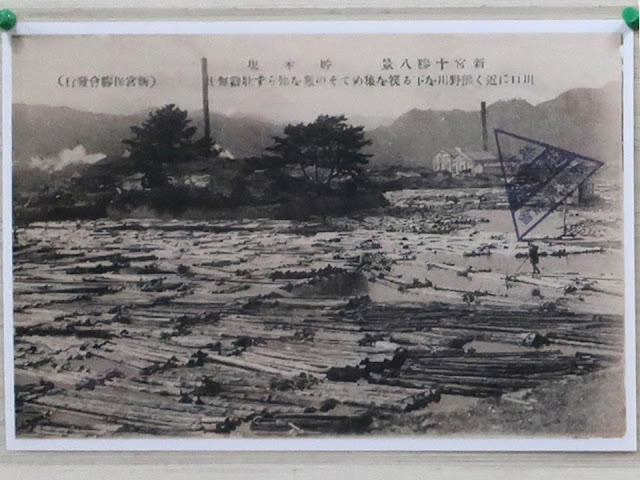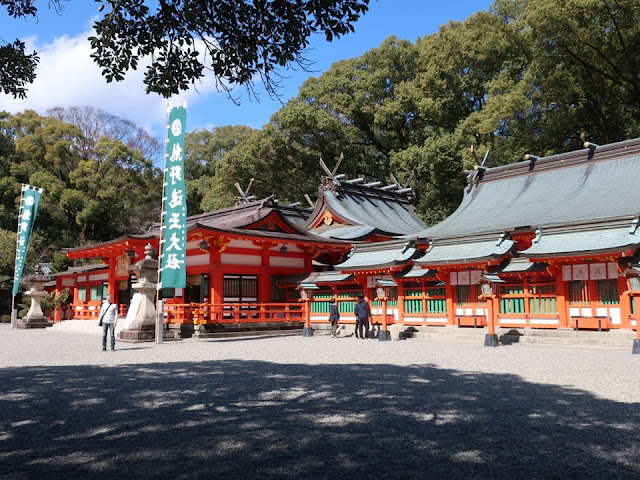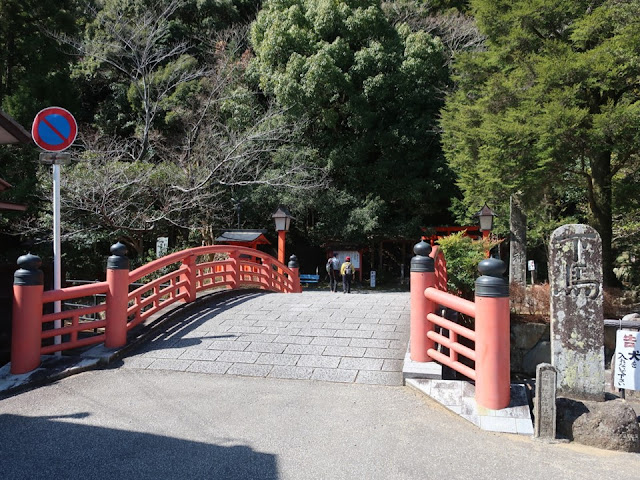Shingu in Wakayama prefecture of western
Japan was a city built originally in front of a famous shrine, Kumano Hayatama Taisha. It is at the mouth
of Kumano River, so it has been a distributing center of woods which
are cut in its mountainous area. The museum shows us not only its history but
also livening of local people. I took photos under the
approval of Shingu City.
The museum is next to Asuka Shrine. The signboard says, “Many mishotai, images of Kumano deities in the forms of Buddha, dating back to the 12th to 15th centuries have been discovered ---, and tell us about religious thought particular to Japan amalgamating Shinto and Buddhism”.
資料館は、阿須賀神社に隣接しています。その案内板に、御神体である蓬莱山の山麓では、熊野の神々を仏として表現した多くの御正体(みしょうたい、12~15世紀)が発見され、「神道と仏教が融合した日本独特の宗教観を知ることができる」と書かれています。
Mishotai are exhibited in the room of the 1st floor. There are two kinds of mishotai. One is a mirror on which Shinto deity or Budda is carved (kyou(mirror)-zou(image), 鏡像). The other one is a cupper plate on which a Shinto deity or Budda is carved. It is hanged (kake(hanging)-hotoke(Budda), 懸仏). People have prayed seriously. It is prohibited to take photos of mishotai closely.
資料館一階の展示室には御正体などが展示されています。御正体は二種あります。神聖視されている鏡に神仏の像を線刻あるいは墨書した「鏡像」と、円形の銅板に神仏の像を線刻あるいは墨書したり取り付けたりし、吊り下げるようにしたものが「懸仏」です。12世紀には大量に生産され、社寺に奉納されました。
神仏習合の影響で、神様と仏様を区別していませんが、人々の願いがこもっています。御正体は、近影での撮影はできません。
At the wall of the staircase, there are exhibits about “Johuku/徐福” on the wall. The first emperor of Qin (China), also known as Qin Shi Huang, ordered Johuku to find an elixir of immortality. Therefore, he came to Japan. There are many legends about his visiting to Japan and Shingu is one of them. A shrine dedicated to him is beside the main hall of Asuka shrine (lower right). He is respected even until now.
二階への階段の壁には、徐福に関する展示がされています。徐福は、秦の始皇帝の命を受け、不老不死の薬を求め日本へ船出したとされています。徐福渡来の伝説は日本各地にありますが、新宮にも伝わっています。阿須賀神社の本殿の隣には、徐福を祀る社があり(右下)、今も敬われています。
I went to the exhibition room on the 2nd floor. The special exhibition “Shingu in the medieval era by knowing through remains – religious and port city at the mouth of Kumano River” was held when I visited. The faith to Kumano deities flourished at that time. There are not only religious remains, but also ceramic products from all over Japan and so on.
二階の展示室に行きます。中央の展示ケースは原始時代、奥は江戸時代(主に紀伊藩付家老の水野氏)の展示です。訪問時には、「遺跡から見た中世新宮の町~熊野川河口の宗教港湾都市~」という企画展が行われていました。中世に熊野信仰が隆盛し、社寺などの宗教遺跡だけでなく、日本各地の焼き物や倉庫群など、港町らしい遺跡も残っています。
There are many exhibits about the local living which is the theme of this blog.
The photo above shows the whaling which continued until around 19th century. When they fished a whale, they had a solemn ceremony which was imitated the one of a victory. Nowadays, locals offer a whale dance to the local shrine (Miwasaki Hachiman shrine) in September. The dance imitates whale fishing.
さて、私の関心事である人々の暮らしの展示。
明治まで続いた鯨漁。鯨の陸揚げの時には、戦いの凱旋になぞらえて厳粛な儀式を行いました。今は、鯨漁を踊りにした鯨踊りが、9月中旬に三輪崎八幡神社に奉納されています。
The exhibits above are concerning agriculture in old days. The ploughing contest by a caw and a person was held in July (upper left). Evaluation items were appearance of a cow, walking and its speed, and cowherd’s technic. Many spectators gathered. The skill to work with a cow was worth watching, I knew.
農耕に関する展示です。毎年7月に行われていた「田掻競牛(たがききょうぎゅう)」(左上)。牛の良し悪し、歩き方、速度、使い手の技術を競いました。写真のように多くの見物客が集まりました。牛と一緒に働く技は、見応えがあったのですね。
Forestry prospered in the modern era. Quality woods of Kumano were popular. The population tripled in thirty years, because the demand of woods increased rapidly after the Great Kanto earthquake in 1923. The population is almost same even now (around thirty thousand).
林業は近代に活況を呈しました。良質な熊野材は人気で、木材需要が急増した関東大震災の後(大正末)には、人口が30年前の約三倍、28,000人になりました。今と同等です。
Woods are cut and branches are removed in a mountain, then logs are collected. Logs were drawn on crossties; it was a manual work back then. I’m sure he was proud of his work.
木材は、山中で切り倒し、枝を落とし、丸太にして集積所に集めます。そして、枕木を敷いた木馬(きんま)道を運び出します。機械が無い頃は力仕事。彼の顔に誇りを感じます。仕事への誇りと働く楽しみがあったと思います。
After arriving at a river, they made a raft of woods and floated it. A large raft could bring several hundreds of woods at once. They had to worked at the risk of their life. Younger brothers engaged in the work, because the eldest son was a successor of the family back then. It is written that the skill of Kumano raftsmen was high, so they worked even in China until the WW2. I'm sure it was a rewarding job. Woods are transported by trucks nowadays, but it is said that the raft transportation continued until 1964.
木材を川まで運ぶと筏流しです。大きな筏では、数百本の木材を運びました。命がけの仕事で、次男以下が従事しました。「熊野の筏師の技術は非常に高く、戦前、戦中には満州や鴨緑江へ出稼ぎに行く筏師がいるなど国際的に活躍していた」と書かれています。やりがいのある仕事に違いありません。今はもちろんトラック輸送。市中の案内板には、昭和39年まで続いたと書いてありました。
The lumberyard in Shingu was huge, so it was a sightseeing spot.
下流の新宮市の貯木場は「新宮十八景」として絵葉書になるほど大規模なものでした。
The photo above shows the street of Kawara (river beach) – machi (town). It was at the mouth of Kumano River until early 20th century. They built huts with few nails, because they moved the huts during flood. Inns for raftsmen, blacksmiths, restaurants and so on were operated. The number of huts were more than two hundreds at the peak time. The lyrics of a local song (Shingu-bushi) says, “Kawara is so good that you can make money and can build a storehouse in three years and three months if there are no flood." It was a town of smell of money.
The photo in behind is a picture postcard published in France, the one at lower left is a Japanese postcard and the model at lower right is a hut.
こちらは熊野川河口の権現川原にできた川原町。昭和の初めまでありました。釘をほとんど使わずに小屋を建て、増水時には小屋を退避させました。筏師らの船宿を中心に、鍛冶屋や飲食店などが軒を連ね、多い時は200戸を越えました。新宮節に「川原よいとこ 三年三月 出水さえなけや 倉が建つ」と歌われました。金の匂いがする町です。
上はフランスの絵葉書になった川原町、左下は日本の絵葉書「紀伊熊野百景」、右下は川原屋の模型です。
The raftsmen returned to their mountain villages through the path above. The photo at lower right shows rice balls rapped with pickled leaves. Raftsmen and forestry workers ate them as lunch. It was big so they ate with eyes wide open (“mehari” in Japanese). The local favorite was named “mehari-sushi”.
筏師が山の集落へ戻るための道です。右下は郷土料理のめはりずし。握り飯を高菜の漬物でくるんだもので、林業従事者や筏師の弁当でした。目を見張るほどの大きさ(腹が減りますものね)。
The prime time of Kumano forestry had gone since 1950s, because of imported woods. They are suffered from the labor shortage now, but they tackle to rise demand by the branding strategy of Kumano woods.
昭和30年代以降、外国材に押され林業は衰退しました。現在の林業は、従事者不足に悩む一方、熊野材のブランド化による需要拡大に取り組んでいます。
There are wooden propellers which were used at a sightseeing boat of Kumano River. Those were very nosy, so they were changed to screws. A staff told me about it; he experienced to ride on the propeller boat.
民具の展示コーナーに木製のプロペラがありました。水深が浅い瀞峡の観光船に使われていましたが、うるさいのでスクリューに代わったそうです。乗ったことがあるという受付の方の話です。
Sightseeing in Shingu City、新宮市内観光
It’s the place where Kawara–machi was. There is a shopping street named “Kawara-ya-yokocho” inside the bank (lower left). There is also a restored hut.
川原町があった辺りです。今は堤防の内側に、川原屋横丁として、お店があります(左下)。復元した小屋も見学できます。
Kumano Hayatama Taisha (shrine) is next to Kawara-machi. It’s the symbol of Shingu City.
隣には、熊野三山の一つ、熊野速玉大社があります。新宮市のシンボルです。
The deity descended at the shrine above (Kamikura shrine), and was enshrined at Kumano Hayatama Taisha.
熊野の神様は、上の神倉神社に降臨し、その後、熊野速玉大社(新宮)に祀られました。
The approach consists of the 538 stone steps. I didn't have enough time to climb.
538段の石段の参道です。時間の都合で諦めました。残念。
I had a “mehari-zushi” as lunch. Those were simple taste.
道の駅で買った「めはりずし」、素朴ですね。
Official
website: https://www.city.shingu.lg.jp/info/918
(in Japanese), accessed in October, 2023
Visited in
March, 2023
Previous post (museum in the neighboring city): Matoya
Bay and Shima city history and folklore museum、的矢湾と志摩市歴史民俗資料館
Next post (the other Kumano shrine with a great waterfall):Kumano Nachi Taisha (shrine)、熊野那智大社




















Comments
Post a Comment